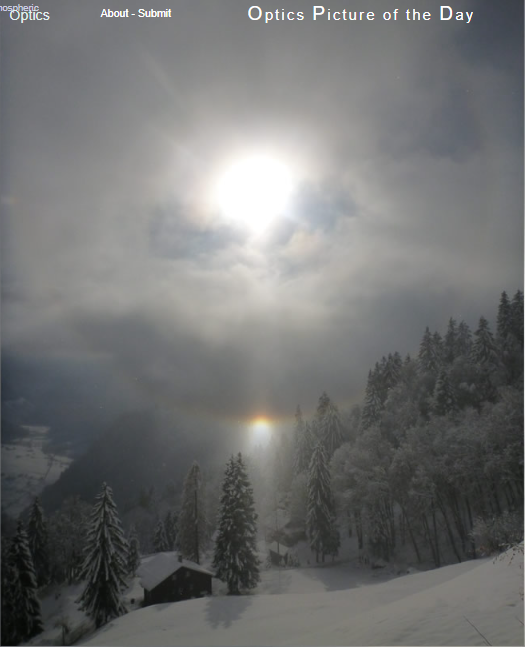OPOD - Diamond Dust Halos, Switzerland
OPOD - Diamond Dust Halos, Switzerland: A Spectacular Atmospheric Phenomenon
Diamond Dust, a mesmerizing atmospheric phenomenon, recently graced the skies of Switzerland. Willem Koppenol, a keen observer of nature's wonders, captured this breathtaking scene at Braunwald, situated at an altitude of 1382m. The individual crystals of diamond dust sparkled brilliantly, creating a spectacle that adorned the horizon with a stunning display of halos. In this article, we delve into the enchanting world of diamond dust and explore the fascinating halos it produces.
Halos are optical phenomena caused by the interaction of sunlight with ice crystals suspended in the atmosphere. Diamond dust, a type of ice crystal, can form under specific weather conditions, such as extremely cold temperatures and high humidity. These tiny ice crystals, resembling glittering diamonds, float through the air, catching the sunlight and scattering it in various directions. The result is a shimmering spectacle that captivates onlookers.
One of the most prominent halo formations caused by diamond dust is the 22° halo. This halo appears as a circular ring around the sun or moon and is named for its approximate radius in degrees. The 22° halo is formed when sunlight enters the hexagonal ice crystals and undergoes refraction and reflection processes within the crystal structure. As a result, the light is bent at specific angles, creating a circular halo that surrounds the celestial body.
In the case of the diamond dust halos observed in Switzerland, an additional phenomenon known as a lower tangent arc made an appearance. The lower tangent arc touches the 22° halo at its lowest point and extends downward. This arc occurs when sunlight undergoes refraction within horizontally oriented ice crystals. The combination of these two halo formations created a truly mesmerizing sight in the Swiss skies.
It is worth noting that diamond dust halos are not limited to the 22° halo and the lower tangent arc. The atmosphere is capable of producing a wide range of halo variations, each with its own unique characteristics. These include rare arcs such as the upper tangent arc, Parry arc, and the circumzenithal arc, to name a few. Each of these arcs occurs under specific conditions and offers a distinct visual experience for those fortunate enough to witness them.
The presence of diamond dust halos serves as a reminder of the intricate beauty that can be found in the natural world. These phenomena are not only visually captivating but also provide valuable insights into the physics of light and the behavior of ice crystals in the atmosphere. By studying and understanding these optical phenomena, scientists can gain a deeper understanding of atmospheric processes and improve their ability to predict and explain various meteorological phenomena.
In conclusion, the recent sighting of diamond dust halos in Switzerland was a sight to behold. The glimmering crystals suspended in the air created a stunning display of halos, including the prominent 22° halo and the lower tangent arc. These atmospheric phenomena serve as a testament to the beauty and complexity of nature. As we continue to explore and unravel the mysteries of the atmosphere, we can look forward to more awe-inspiring displays of diamond dust halos and other enchanting optical phenomena. So, keep your eyes on the skies and prepare to be amazed by the wonders that await!

Diamond Dust, Switzerland
Willem Koppenol captured the scene at Braunwald, altitude1382m.
Diamond dust, whose individual crystals glinted brightly and speckled the larger image, created the below horizon halos. A 22° halo is touched at its lowest point by a lower tangent arc. A rarer arc was visible but that deserves an OPOD all of its own.
©Willem Koppenol, shown with permission.

Note: this article has been automatically converted from the old site and may not appear as intended. You can find the original article here.
Reference Atmospheric Optics
If you use any of the definitions, information, or data presented on Atmospheric Optics, please copy the link or reference below to properly credit us as the reference source. Thank you!
-
<a href="https://atoptics.co.uk/blog/opod-diamond-dust-halos-switzerland/">OPOD - Diamond Dust Halos, Switzerland</a>
-
"OPOD - Diamond Dust Halos, Switzerland". Atmospheric Optics. Accessed on November 26, 2024. https://atoptics.co.uk/blog/opod-diamond-dust-halos-switzerland/.
-
"OPOD - Diamond Dust Halos, Switzerland". Atmospheric Optics, https://atoptics.co.uk/blog/opod-diamond-dust-halos-switzerland/. Accessed 26 November, 2024
-
OPOD - Diamond Dust Halos, Switzerland. Atmospheric Optics. Retrieved from https://atoptics.co.uk/blog/opod-diamond-dust-halos-switzerland/.